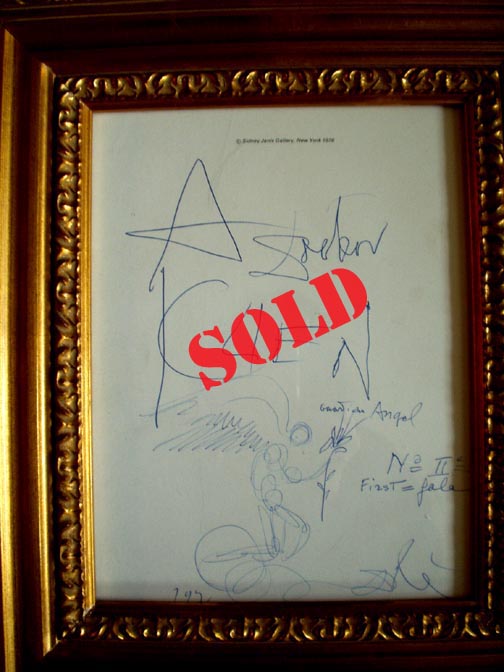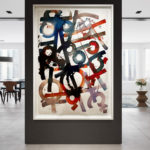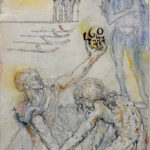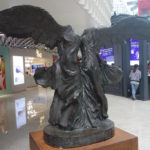Ink on catalogue, “The Photographer & The Artist” Sidney Janis, (1976) , 6.5” x 8” (16.5cm x 20.3cm)
The spirit of the guardian angel theme, emblematic of the Klein Collection, is wonderfully captured in this very special drawing, showing a reverently kneeling angel holding an olive branch, a symbol of peace and hope. This thoughtful work was made in the 32-page catalogue, The Photographer & The Artist, opening 4-7pm, thru March 6, 1976 at Sidney Janis, 6 West 57th. New York. (Copyright 1976).
Dedicated to Dr. Klein, the work featured the words “guardian angel” in Dali’s handwriting, along with this important hand-written designation: “No. II. First = Gala”. This, of course, meant Dr. Klein was second only to Gala (Dali’s beloved wife) as his reigning guardian angel! This realization is more significant than one might first imagine. Clearly Dali was hyper-aware of his mortality, and was facing this inevitability when he first enlisted the intervention of Dr. Klein. Although the details are unknown, it is clear that Dr. Klein helped Dali get through and go beyond his medical concerns. Dali putting Dr. Klein second only to Gala as his “Guardian Angel” speaks volumes about the painter’s feelings for his physician.
It is also significant to note that one of Dali’s most important paintings in the 1952 work, “The Angel of Port Lligat”, which portrays his wife Gala as a winged angel along the shore of their Spanish Home. Moreover, one of the watercolors in the collection of Mrs. Albert D. Lasker, whose Foundation honored the work of Dr. Klein, was “Guardian Angel of Cadaques” of 1943.
The Dr. Edmund Klein Collection of Salvador Dali original drawings
By Paul Chimera
This is the story of two great 20th century pioneers who came together in a remarkable union of medical and artistic genius: Dr. Edmund Klein and painter Salvador Dali. It resulted in a unique collection of original drawings that… have never before been seen by the art world.

Dali’s Guardian Angel:
Thirteen Dali drawings, plus a Dali sculpture, represent not only a veryspecial collection of art, but an intriguing page of art history.
Edmund Klein, MD (1921-1999) was a renowned dermatologist and skin cancer expert. His medical career led him to Boston, Mass, where he worked as a researcher with the Sidney Farber Research Foundation. In 1964, Dr. Klein accepted the position of Chief of Dermatology at the world-renowned Roswell Park Cancer Institute in Buffalo (NY) There he developed the protocol for the application of a highly effective topical anticancer agent for the skin cancer. Eventually Dr. Klein settled with his wife and five children in Williamsville, NY, a Buffalo suburb. He was the recipient of the highest award in American medicine-the prestigious Lasker Award for clinical research in cancer immunology. One observer, in describing Dr. Klein’s extensive professional accomplishments, called him the “Father of modern immunology”.
Martha Klein, Dr. Klein’s wife, explains how her husband originally forged a connection with Salvador Dali. “Mary Lasker (of the aforementioned Lasker Foundation) knew my husband by the late 1960’s, and in 1972 he received the Lasker Award. Around the same time, Dali’s manager called the house and said, ‘Salvador Dali calling for Dr. Klein’. I think Mary Lasker was the connection. I was very thrilled with that call!”
“They set up their first appointment”, Mrs. Klein continued, “and he went to New York to see Dali for the first time. He saw him often after that, probably 15 times, both at the St. Regis and in Europe.”
It is unclear precisely what medical condition Dali had-or feared he had- that led him to Dr. Klein’s door. Surely Dali’s manager was instructed to spare no expense in finding the best of the best to treat, or at least consult with, the wealthy, world famous Catalan master. Dali lived all his life in Port Lligat, Spain, or on the Costa Brava, spending many hours in the Mediterranean sun when he wasn’t hard at work in his studio, or traveling to Paris, Madrid, Monte Carlo or New York. Although Dr. Klein was, as a July 30, 1999 New York Time obituary stated, an “expert on skin cancer.” He never revealed- not even to his wife- the exact nature of Dali’s condition, rigorously maintaining doctor/patient confidentiality. But whether Dali had, in fact, a form of skin cancer, or some other sun-related skin problem, he and Dr. Klein developed a close personal relationship, each respecting the other’s expertise in their chosen field. “He never discussed the nature of the illness that Dali had”, Mrs. Klein remembers. “Edmund adored Dali and had a great appreciation of those drawings. I cannot even imagine his state of mind as he sat there and Dali drew and explained to him exactly what each one meant.”
Dr. Klein, born in Vienna and receiving his M.D. in 1951 from the University of Toronto, never charged Dali for his medical consultations and treatments. Mrs. Klein notes that the two men had a close relationship that went beyond a professional one; they would often dine together at the St. Regis Hotel and spend time together as friends.
Part of that time saw Dali take up pen, ink even crayon; to create 11 original drawings for the man he called his “Guardian Angel”. Mrs. Klein remembers that Dali brought the books [some in the collection were drawn on] to their meetings, not her husband. Whatever Dr. Klein did for Dali medically, it obviously made an enormous impression on him, and earned his abiding respect and admiration. Indeed, the Guardian Angel idea is carried out thematically among the majority of the drawings inscribed to Dr. Klein. One sketch even states in Dali’s handwriting that Dr. Klein was the artist’s “Guardian Angel No. II”- right behind Gala (Dali’s wife), of course, as number One!

The collection of Dr. Edmund Klein
Another work, referred to as Dali & DNA, featured three angelic figures-one holding a caduceus (medical staff), intended to represent Dr. Klein himself. Thus, from 1972 to the early 1980’s, Dr. Klein acquired an impressive collection of one-of-a-kind dedicatory drawings, most executed on blank pages of Dali books the artist would bring with him, create in, then give to his surrealist soul mate. Several were drawn in Dali’s sketchbook, another in a rare exhibition catalog. One Dali sculpture, called St. John the Baptist- fashioned directly from Dali’s hands, not merely produced by artisans working off a Dali design- is also part of the Klein collection, together with a unique authenticating statement written by Dali himself.
Below you will find] each of the works in the Klein Collection, accompanied by a brief description and in some cases alluding to other works by Salvador Dali for reference purposes. The drawings help tell a story that spans decades, but which has never been shared outside the Klein family of Western New York and a few close friends- until now.
The Journal of Medicine, in its VOL. 30, No. 5 & 6 (1999), noted- after a listing of Dr. Klein’s achievements: “There was more to Ed Klein, the man, than the accomplishments listed above. We will never forget watching him evaluate patients at almost midnight, speaking to with them while leaning upon his glass covered Salvador Dali masterpiece stretched out on this consultation room desk…”
Dedicatory drawings by Dali are being accorded the status they deserve as legitimate and often quite interesting examples of the Master’s original handiwork- at times more spontaneous, at times quire thoughtfully executed. At least two commercially produced books have now been published that focus exclusively on such works. One is Salvador Dali Dedicatories, Editorial Mediterrania, 1990; and a second A Sabater Con un Abrazon en el Quin Elisabet: Dali, by Enrique Sabater, Umberto Allemandi, & Co. 1998.
The works of the Klein Collection are guaranteed by the owner, Mrs. Edmund Klein who confirmed their provenance. All works were executed expressly for, and in the presence of, the late Dr. Edmund Klein. They were gifts from the artist to Dr. Klein; have been through no other hands and have rarely been shown to the public.








